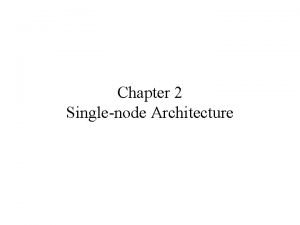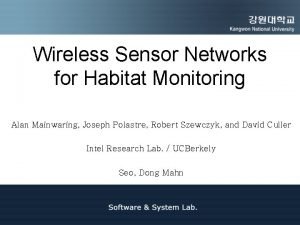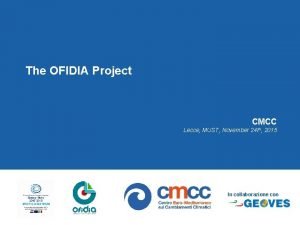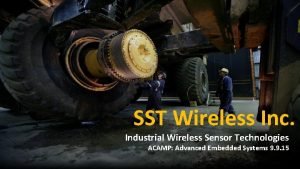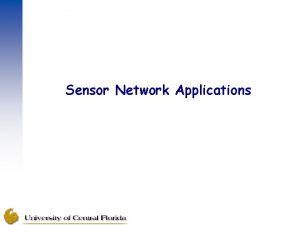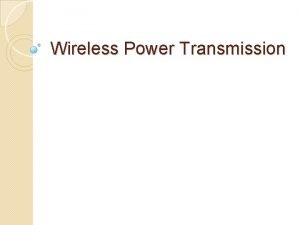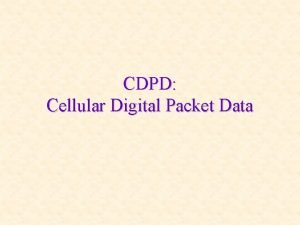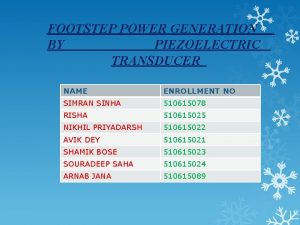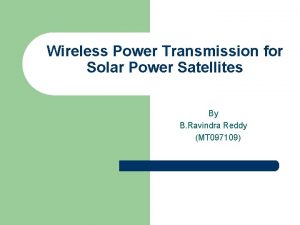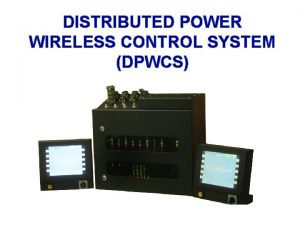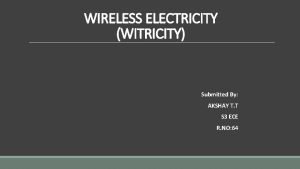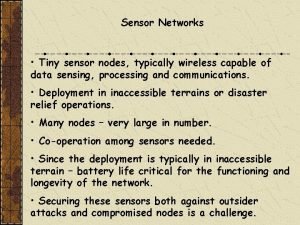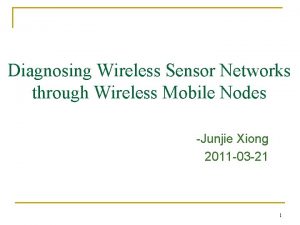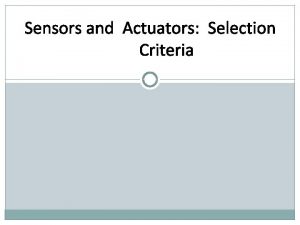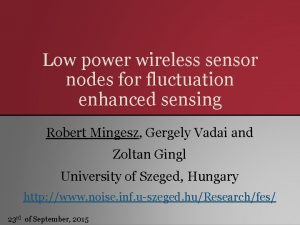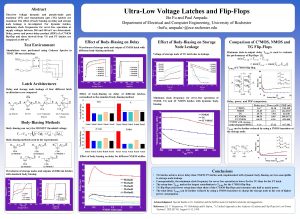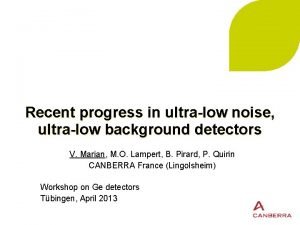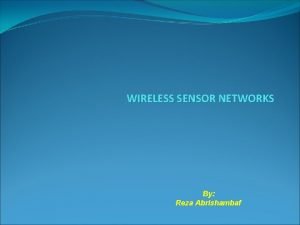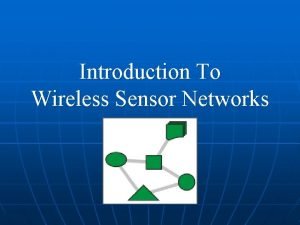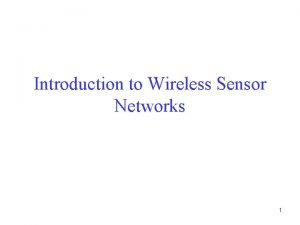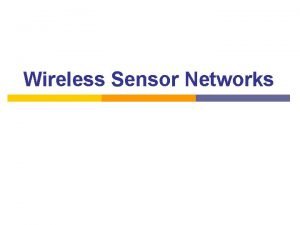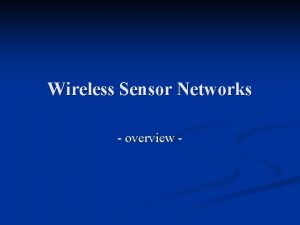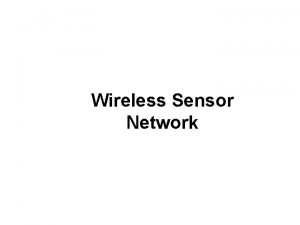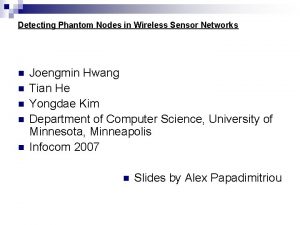Ultralow power and ultralow cost wireless sensor nodes














- Slides: 14

Ultra-low power and ultra-low cost wireless sensor nodes An integrated perspective Jan M. Rabaey EECS Dept. Univ. of California, Berkeley

Pico. Radio’s ─ The Original Mission Meso-scale low-cost radio’s for ubiquitous wireless data acquisition that • are fully integrated –Size smaller than 1 cm 3 • minimize power/energy dissipation – Limiting power dissipation to 100 m. W enables energy scavenging • and form self-configuring ad-hoc networks containing 100’s to 1000’s of nodes Still valid, but pushing the limits ever further

The Incredibly Shrinking Radio 4 mm LNA Test PA Test TX 1 Passive Test Structures Receiver Env Det Test RF Amp Test Diff Osc TX 2 • Technology: 0. 13 mm CMOS combined with off-chip FBARs • Carrier frequency: 1. 9 GHz • 0 d. Bm OOK • Two Channels • Channel Spacing ~ 50 MHz • 40 kbps/channel • Total area < 8 mm 2

Wireless Sensor Network Protocol Processor 64 K memory Neighbor List Locationing Engine Base Band Voltage Conv GPIO Serial Interface DW 8051 μc System Supervisor DLL Network Queues Technology 0. 13μ CMOS Chip Size 3 mm x 2. 75 mm = 8. 2 mm 2 Transistor Count 3. 2 M Gate Count 62. 5 K gates Clocks Freqs 16 MHz(Main), 1 MHz(BB) On Chip memory 68 Kbytes Core Supply Voltages 1 V(High) – 0. 3 V(Low) On_Power < 1 m. W Standby Power m. Ws In fab (Jan 04) Integrates all digital protocol and applications functions of wireless sensor node Runs reliable and energy-optimized protocol stack (from application level down)

The Road towards a First Integrated Pico. Node Digital s s 16 k. B CODE Flash Storage 4 k. B XDATA 256 DATA DW 8051 20 MHz Clock Source Serial Powertrain Solar Cell Voltage Supply Flash. IF rd D a o B User Interface SIF Serial GPIO ADC PHY Prg. Thresh 0 Prg. Thresh 1 OOK Receiver SIF ADC MAC Local. HW Sensor 1 Sensor 2 n g i es sfrbus or membus? In e c o r Chip P Supervisor Network Processor Tx 0 Tx 2 RF Transceiver OOK Transmitter SIF = sensor interface

Energy-Scavenging becoming a Reality • Demonstrate a self contained 1. 9 GHz transmitter - powered only by Solar & Vibrational scavenged energy • Push integration limits - limited by dimensions of solar cell Front regulator cap Tx COB Light Level Low Indoor Light Fluorescent Indoor Light Partly Cloudy Outdoor Light Bright Indoor Lamp High Light Conditions Vibration Level 2. 2 m/s 2 5. 7 m/s 2 Duty Cycle 0. 36% 0. 53% 5. 6% 11% 100% Duty Cycle 1. 6% 2. 6%

Perspectives: Where are we heading? • Extrapolating towards the future: how far can we push cost, size, and power? – Ultra-dense sensor networks (“smart surfaces”) enabled by sub 10 m. W nodes. – Cutting RF power by at least another factor of 5 (if not more) – Pushing the boundaries on voltage scaling • Focus on the application perspective – A Service-based Application Interface for Sensor Networks – Focus on issues such as portability, universality , scalability, and ad-hoc deployment

An Application Perspective to Sensor Networks A plethora of implementation strategies emerging, some of them being translated into standards Tiny. Os/Tiny. DB The juggernaut is rolling … but is it the right approach? • Bottom-up definition without perspective on interoperability and portability • Little reflection on how this translates into applications

A Quest: A Universal Application Interface (AI) for Sensor Networks • • Supports essential services such as queries, commands, time synchronization, localization, and concepts repository Similar in concept to the socket interface in the internet Provides a single point for providing interoperability Independent of implementation architecture and hardware platform – Allows for alternative PHY, MAC, and Network approaches and keeps the door open for innovation Application Interface Query/Command SNSP Service Layer Naming Time/Synchronization Location Network Layer

SNSP Status (joint project with GSRC (ASV) and TU Berlin) • White paper completed and in feedback gathering mode (http: //bwrc. eecs. berkeley. edu/research/picoradio/. . . ) • Very positive support so far (both from industry and academia) • Next targets: – Further evolve document (start working group) – Demonstrate feasibility by implementation on at least two test beds – Address number of issues left open for research (e. g. implementation approaches for naming, synchronization, localization, and concept repository services) • Currently in process of acquiring funding (NSF, European Commission, CEC, …)

Extrapolation of the low-power theme: Ultra-dense sensor networks • How to get nodes substantially smaller and cheaper (“real” mm 3 nodes): get them closer, use lots of them, and make their energy consumption absolutely minimal (this is < 10 m. W). • “Smart surfaces”: plane wings, smart construction materials, intelligent walls • How to get there? Go absolutely non-traditional! – Use non-tuned mostly passive radio’s – center carrier frequency randomly distributed – Use statistical distribution to ensure reliable data propagation

On the Road: Reducing RF power by another factor of 5 • Providing gain at minimal current: The Super-regenerative Receiver 1500 mm • 400 m. A when active (~200 m. W with 50% quench duty cycle) 1200 mm • Fully Integrated Back from fab any day

Realizing sub-50 m. W receivers Example: sub-threshold RF oscillator using integrated LCs (in fab) Simulated Performance Supply voltage 0. 5 – 1. 2 V Current consumption 150μA Oscillation frequency 1. 5 GHz Differential output swing 150 m. V (Vdd=500 m. V) Phase noise -100 d. Bc/Hz @1 MHz offset Next step: mostly untuned radio’s and lots of them Combine with purely statistical routing (in collaboration with Kannan)

Ultra-Low Voltage (ULV) Digital Design • Aggressive voltage scaling the premier way of reducing power consumption; Performance not an issue • Our goals: design at 250 m. V or below • Challenges: – Wide variation in gate performance due to variability of thresholds and device dimensions – Sensitivity to dynamic errors due to noise and particle-caused upsets (soft errors) Explore circuit and architecture techniques that deal with performance variations and are (somewhat) resilient to errors! TM TM Tcl’ asynch. TM Time reference Chip Supervisor synch. Idea: Self-adapting approach to ULV Status: White paper
 Telecommunications, the internet, and wireless technology
Telecommunications, the internet, and wireless technology Wireless sensor network protocols
Wireless sensor network protocols Single node architecture in wsn
Single node architecture in wsn Wireless sensor networks for habitat monitoring
Wireless sensor networks for habitat monitoring Wireless sensor network ppt
Wireless sensor network ppt Forest geove
Forest geove Sensor wireless inc
Sensor wireless inc Habitat monitoring sensor
Habitat monitoring sensor Advantages and disadvantages of wireless power transmission
Advantages and disadvantages of wireless power transmission Power triangle formula
Power triangle formula What is cdpd
What is cdpd Footstep power generation using piezoelectric sensor
Footstep power generation using piezoelectric sensor Wireless power transmission project report doc
Wireless power transmission project report doc Dpwfs
Dpwfs Wireless electricity
Wireless electricity


